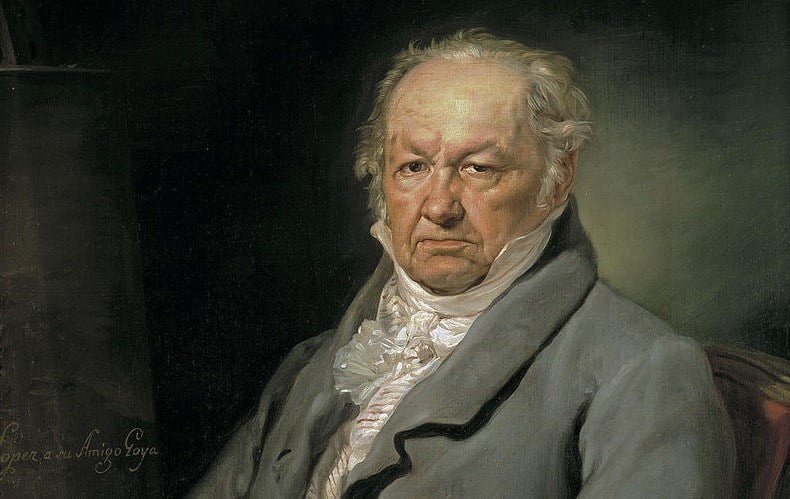Francisco de Goya, a renowned Spanish painter, draftsman, and engraver, left an indelible mark on the art world, contributing to the initiation of the romantic style and laying the foundations for contemporary painting. Born on March 30, 1746, in Fuendetodos, Spain, Goya’s artistic journey unfolded against the backdrop of personal challenges, triumphs, and a changing political landscape.
Goya Early Years and Artistic Training:
Goya’s artistic journey commenced at the age of 13 when he entered the drawing school under the guidance of the baroque painter José Luzán y Martínez. Despite initial struggles, he embarked on a path of self-discovery, gradually transitioning from apprentice to an artist of his own imagination. His artistic prowess developed slowly, marked by participation in painting contests and a quest for new mentors.
Travels and Influences:
In pursuit of artistic growth, Goya traveled through Madrid, Rome, Venice, and Italy, ultimately becoming a disciple of the painter Francisco Bayeu. The Italian Notebook, a diary filled with sketches and annotations, captures the experiences and inspirations gained during this transformative period. His style evolved, as seen in the Parma contest entry, signaling a departure from traditional norms.
Family and Professional Milestones:
Returning to Spain in 1771, Goya faced family crises but seized the opportunity to gain recognition by painting the coral vault of the Basilica of Our Lady of Pilar de Zaragoza. His marriage to Josefa Bayeu in 1773 marked a personal milestone, and the couple had seven children. Goya’s talents extended to tapestry design, contributing notable works such as “The Blind Chicken” and “The Potter” until a tragic accident led to his irreversible deafness.
Court Connections and Academy Recognition:
Working as a tapestry designer provided Goya access to the court’s art collections, influencing his style, particularly by the works of Velázquez. In 1780, his painting “Christ on the Cross” earned him entry into the Royal Academy of Fine Arts of San Fernando. Over the years, he portrayed Madrid’s high society, securing recognition as one of the King’s painters in 1786 alongside Francisco Bayeu.
Deafness and Artistic Evolution:
Deafness marked a turning point for Goya, leading to increased introversion. His art began to reflect a distorted reality, portraying the grotesque aspects of life. In a 1792 speech at the Academy, he advocated for artistic freedom, expressing concerns about restricting artists with rigid rules.
Personal Loss and Political Unrest:
Goya’s life was marred by personal losses, including the death of his wife in 1812. The unfolding War of Spanish Independence in 1808 deeply affected him, inspiring graphic engravings depicting the atrocities of the conflict. His encounters with the Duchess of Alba and Queen Maria Luisa prompted the creation of the series “Caprichos” in 1799.
Later Years and Legacy:
As Goya aged, he continued to engage with political themes, producing works like “The Burden of the Mamluks” and “The Executions of the Third of May” in response to Ferdinand VII’s reign. By 1826, he sought retirement and embarked on self-imposed exile with friends. Health problems plagued his later years, leading to his death on April 16, 1828.
Conclusion:
Francisco de Goya’s artistic journey mirrors the complexities of his time, blending personal struggles with a profound impact on the art world. His legacy endures through masterpieces that transcend conventional norms, influencing the trajectory of art well into the 20th century.
FAQ:
1. What influenced Goya’s artistic style?
Goya’s style was influenced by his travels, exposure to court collections, and his evolving perspective shaped by personal challenges, including deafness.
2. What are some notable works by Goya?
Goya’s notable works include “Christ on the Cross,” “The Third of May 1808,” and the series “Caprichos.”
3. How did Goya contribute to the romantic style?
Goya’s departure from traditional norms and emphasis on expressing emotion and reality in his works played a pivotal role in initiating the romantic style.
4. How did Goya cope with deafness?
Goya adapted to his deafness by becoming increasingly introverted, using his art to convey a distorted reality and the grotesque aspects of life.
5. What marked Goya’s later years?
Goya’s later years were marked by political engagement, the creation of patriotic works, and eventual self-imposed exile in 1826.






Leave a Reply